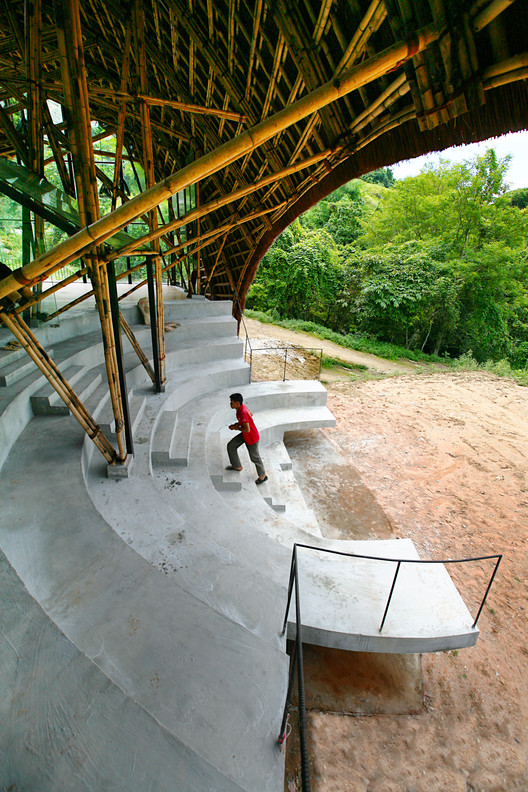Lemur Exhibit Snowdon Architects
2014-03-03 01:00


架构师提供的文本描述。墨尔本动物园的新Lemur展览是与城市倡议(景观建筑师)和动脉设计(解释设计师)合作开展的一个项目,是建筑为提供当代动物园体验作出贡献的一个例子。现有的雨林小径现在有一个高影响力的入场展览,参观者和莱默人在一个非常近的和个人的环境中互动。
Text description provided by the architects. The new Lemur exhibit at the Melbourne Zoo, a project undertaken in collaboration with Urban Initiatives (Landscape Architects) and Arterial Design (Interpretive Designers), is an example of Architecture contributing to the delivery of a contemporary Zoo experience. The existing Rainforest Trail now has a high impact entry exhibit, where visitors and Lemurs interact in an up close and personal environment.
© Drew Echberg
德鲁·埃奇伯格


建造的组件,如入口隧道和树屋,提供书端的沉浸式体验的穿行展览。入口隧道暗示了前方的情况并提高了人们的预期,而树屋则提供了一个思考和参与辖区保护信息的机会。
Built components such as the Entry Tunnel and Tree House provide bookends to the immersive experience of the walk-through exhibit. The Entry Tunnel hints at what lies ahead and heightens anticipation, while the Tree House provides an opportunity for reflection and engagement with the conservation messages of the precinct.
© Drew Echberg
德鲁·埃奇伯格


树屋为完全沉浸式的Lemur展览提供了一个有趣的焦点。它的功能是必要的“气闸”,为游客提供一个分阶段的出口,离开林克斯和游客共用同一空间的鸟巢。与之前的完全沉浸的经验相比,它提供了一个隐蔽的和包含的空间与高架,策划的观点对展览。树屋设计是一个相似的几何‘豆荚’的集合,嵌套在一起,使没有两个豆荚是相同的。
The Tree House provides the playful focal point for the fully immersive Lemur exhibit experience. It functions as the necessary ‘airlock’ providing a staged exit for visitors leaving the aviary where Lemurs and visitors share the same space. Contrasting with the preceding experience of complete immersion, it provides a sheltered and contained space with elevated, curated views over the exhibit. The Tree House design is a collection of similar geometric ‘pods’, nestled together so that no two pods are the same.
© Drew Echberg
德鲁·埃奇伯格


这些吊舱是在现场以外的地方制造和编织成碎片的,并伸长到最后的位置.材料的调色板是克制和同情的莱穆尔雨林景观,马特黑色结构钢和再生木材补充丰富,有机编织藤墙。虽然与之前的展览空间的全方位浸没有很大的不同,但树屋同样继续着分局的任务,把游客运送到墨尔本动物园以外的地方。
The pods were fabricated and woven in pieces off-site and craned into their final position. The material palette is restrained and sympathetic to the Lemurs’ rainforest landscape; matt black structural steel and recycled timbers complement the rich, organic weave of the rattan walls. While quite a departure from the all encompassing immersion of the preceding exhibit space, the Tree House similarly continues the precinct’s mission to transport the visitor far beyond the grounds of the Melbourne Zoo
© Drew Echberg
德鲁·埃奇伯格


重点是通过积极再利用现有的废弃展览来尽量减少对环境的影响,包括改变现有的护城河以容纳一条新的水道。具体说明了回收材料,并采用了低维护、低寿命的冲击材料。树屋通过设计与公众接触和鼓励有关生境保护和可持续性问题的方式,可能是它对环境可持续性的最大贡献。
There was a focus on minimising environmental impact through active reuse of the existing defunct exhibit, including alteration of the existing moat to accommodate a new waterway. Recycled materials were specified and a preference for low maintenance, low lifetime impact materials adopted. The way the Tree House engages with and encourages the public about matters of habitat preservation and sustainability through design is possibly its greatest contribution to environmental sustainability.


































Architects Snowdon Architects
Location Melbourne Zoo, Elliott Avenue, Parkville VIC 3052, Australia
Category Zoo
Area 135.0 sqm
Project Year 2013
























